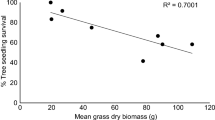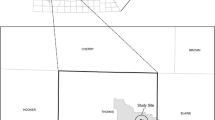Abstract
This study aimed to investigate how perennial grass species in Omo National Park (ONP), Ethiopia tolerated defoliation under varying amounts of rainfall. Perennial grasses that have evolved with grazing appear to be generally tolerant to defoliation, although how rainfall influences this tolerance is unclear. Research was conducted in three perennial grasslands where there is a rainfall gradient from north to south (800 – 500 mm yr−1). Grasslands were characterized as either wet, intermediate or dry sites according to their relative position along the rainfall gradient. The wet, intermediate, and dry sites were dominated by two, five, and two grass species, respectively, which comprised 98% of total plant basal cover at each site. Six exclosures containing a total of 12 defoliated and 12 non-defoliated plots (2 × 2 m) were constructed at each site. Hand-clipped defoliation treatments were imposed bimonthly for 18 months (i.e., four rainy seasons, three dry seasons). Repeated measurements of basal cover and biomass production were analyzed for overall response and by species. Basal cover increased (P < 0.05) or remained unchanged for all but one perennial grass species. Biomass production indicated trend for some species but was sensitive to annual rainfall. Overall results indicated that dominant perennial grasses of ONP were tolerant to defoliation, and this tolerance was expressed under all three rainfall levels. In addition, a decrease (P < 0.05) in basal cover was found for grasses in non-defoliated plots for five of nine cases, indicating a negative response to protection from grazing and fire.
Similar content being viewed by others
References
Belsky A.J. 1985. Long-term vegetation monitoring in the Serengeti National Park, Tanzania. Journal of Applied Ecology 22: 449–460.
Bonham C.D. 1989. Measurements for Terrestrial Vegetation. John Wiley & Sons, New York.
Brady W.W., Mitchell J.E., Bonham C.D. and Cook J.W. 1995. Assessing the power of the point-line transect to monitor changes in plant basal cover. Journal of Range Management 48: 187– 190.
Boutton T.W., Tieszen L.L. and Imbamba S.K. 1988. Biomass dynamics of grassland vegetation in Kenya. African Journal of Ecology 26: 89–101.
Caldwell M.M. 1984. Plant requirements for prudent grazing. In: Developing Strategies for Rangeland Management. National Resource Council, National Academy of Science. Westview Press, Boulder, CO, USA, pp. 117–152.
Coughenour M.B., McNaughton S.J. and Wallace L.L. 1985. Responses of an African tall-grass (Hyparrhenia filipendula stapf.) to defoliation and limitations of water and nitrogen. Oecologia 68: 80–86.
Deshmukh I.K. and Baig M.N. 1983. The significance of grass mortality in the estimation of primary production in African grasslands. African Journal of Ecology 21: 19–23.
Hand D.J. and Taylor C.C. 1987. Multivariate analysis of variance and repeated measures; a practical approach for behavioural scientists. Chapman and Hall, London.
Hillman J.C. 1993. Ethiopia: Compendium of Wildlife Conservation Information. NYZS-The Wildlife Conservation Society, New York.
Hodgkinson K.C. 1992. Elements of grazing strategies for perennial grass management in rangelands. In: Chapin G. (ed.), Desertified Grasslands: Their Biology and Management. Symposium No.13. Linnean Society of London, London, England, pp. 76–94.
Jones C.A. 1985. C4 Grasses and Cereals: Growth, Development and Stress Response. John Wiley & Sons, New York.
Le Houerou H.N. and Hoste C.H. 1977. Rangeland production and annual rainfall relations in the Mediterranean Basin and in the African Sahelo-Sudanian Zone. Journal of Rangeland Management 30: 181–189.
Jacobs M.J. 1999. Influence of grazing, fire and rainfall regime on plant species dynamics in an Ethiopian perennial grassland. PhD Dissertation, Utah State University, Logan.
Jacobs M.J. and Schloeder C.A. 2002. Fire frequency and species associations in perennial grasslands of southwest Ethiopia. African Journal of Ecology 40: 1–9.
McNaughton S.J. 1979. Grassland-herbivore dynamics. In: Sinclair A.R.E. and Norton-Griffiths M. (eds), Serengeti Dynamics of an Ecosystem. University of Chicago Press, Chicago, pp. 46– 81.
McNaughton S.J. 1988. Large mammals and process dynamics in African ecosystems. Bioscience 11: 794–800.
Milchunas D.G. and Lauenroth W.K. 1993. Quantitative effects of grazing on vegetation and soils over a global range of environments. Ecological Monographs 63: 327–366.
Milchunas D.G., Sala O.E. and Lauenroth W.K. 1988. A generalized model of the effects of grazing by large herbivores on grassland community structure. American Naturalist 132: 87–106.
Norton-Griffiths M. 1979. The influence of grazing, browsing and fire on the vegetation dynamics of the Serengeti. In: Sinclair A.R.E. and Norton-Griffiths M. (eds),Serengeti: Dynamics of an Ecosystem. University of Chicago Press, Chicago, pp. 310–352.
Pratt D.J. and Gwynne M.D. 1977. Rangeland Management and Ecology in East Africa. Hodder and Stoughton, London.
Schloeder C.A. 1999. Investigation of savanna vegetation-determinant relationships using spatial statistics. PhD Dissertation, Utah State University, Logan.
Schloeder C.A. and Jacobs M.J. 1993. Report on a feasibility study conducted in the Omo National Park, Ethiopia. NYZS-The Wildlife Conservation Society, New York.
Smart N.O.E., Hatton J.C. and Spence D.H.N. 1985. The effects of long-term exclusion of large herbivores on vegetation in Murchison Falls National Park, Uganda. Biological Conservation 33: 229–245.
Thornton D.D. 1971. The effect of complete removal of hippopotamus on grassland in the Queen Elizabeth NP, Uganda. East African Wildlife Journal 9: 47–55.
Vallentine J.F. 1990. Grazing Management. Academic Press, San Diego.
Watson L. and Dallwitz M.J. 1992. Grass Genera of the World. CAB International, Wallingford, Oxon, UK.
Author information
Authors and Affiliations
Corresponding author
Rights and permissions
About this article
Cite this article
Jacobs, M.J., Schloeder, C.A. Defoliation effects on basal cover and productivity in perennial grasslands of Ethiopia. Plant Ecology 169, 245–257 (2002). https://doi.org/10.1023/A:1026081723022
Issue Date:
DOI: https://doi.org/10.1023/A:1026081723022




